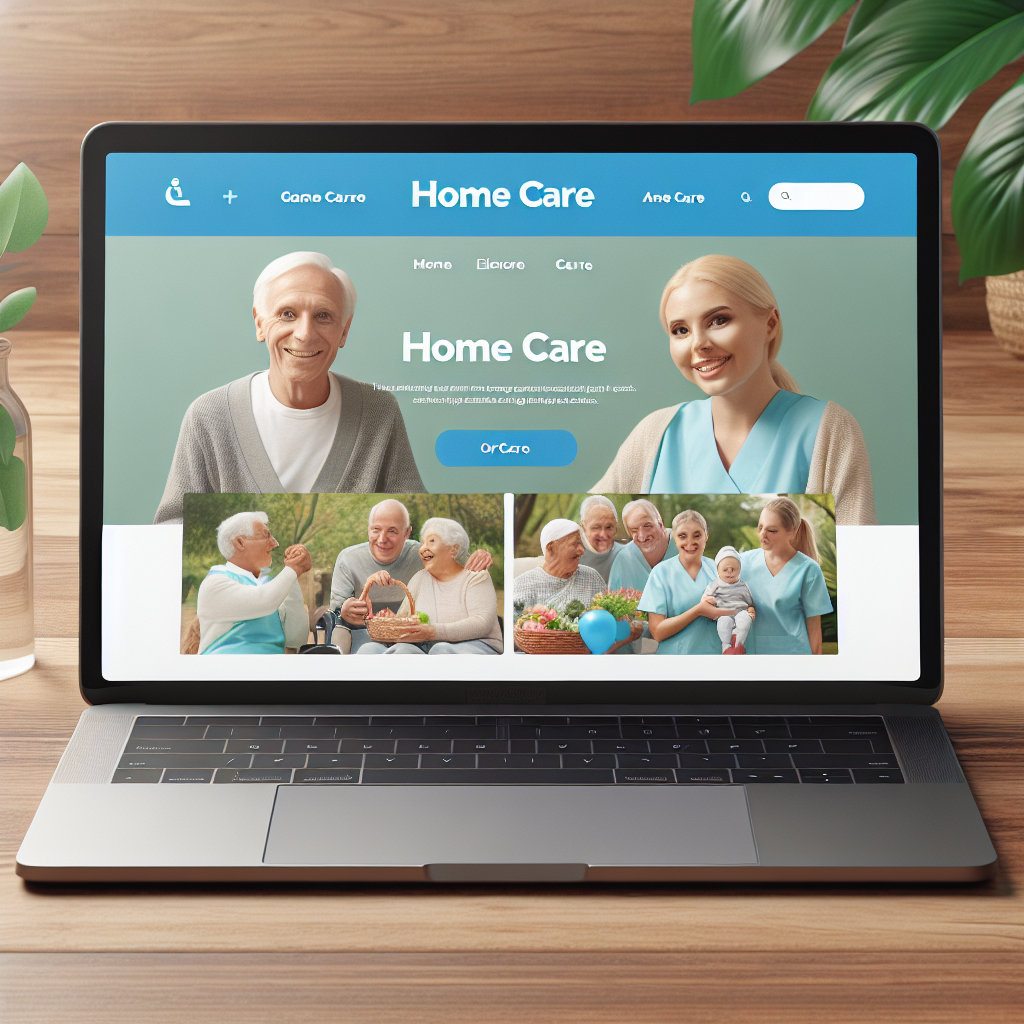Essential Features Every Home Care Website Should Have
Introduction
Welcome to the digital age of home care! If you’re on the hunt for a home care website that truly shines, you’ve landed in the right spot. Just like a cozy blanket on a chilly evening, your website should wrap around potential clients and their families, offering warmth, comfort, and clarity. After all, when it comes to selecting home health care services, families want to feel secure and informed.
Imagine this: You’re an adult child looking for senior home care options for your aging parent. You stumble upon a website that’s as easy to navigate as your favorite streaming service. You can find everything from in-home nursing care details to heartwarming stories about how caregivers have made a difference in their clients’ lives. Sounds dreamy, right? Well, that’s exactly what we aim for!
In this blog post, we’ll dive into the essential features every home care website should have. From comprehensive service descriptions to client testimonials that tug at your heartstrings, we’ll cover it all! So grab a cup of coffee (or tea), get comfy, and let’s explore how to make your home care website not just functional but also inviting.
Did you know? Home health aides make up the largest segment of the home healthcare workforce, making it crucial to highlight their role on your site! (Source)
Ready to jump into the nitty-gritty? Let’s uncover what makes a stellar home care website tick!
Understanding the Importance of a Home Care Website
In today’s digital age, having a well-crafted home care website is not just a luxury; it’s an absolute necessity. Think of it as your virtual storefront an inviting space where families can explore the myriad of home health care services you offer, from senior home care to specialized in-home nursing care. A well-structured website serves as the first impression for potential clients, and we all know how crucial first impressions can be!
But wait, there’s more! A home care website isn’t merely an online brochure. It’s a dynamic platform that helps families navigate the often overwhelming world of elderly care services. Imagine a concerned adult child searching late at night for solutions to their aging parent’s needs. Your website could be their guiding light, offering insights into everything from personal care assistance to respite care services.
Key Point: An effective home care website enhances credibility and builds trust with potential clients by showcasing your expertise in providing compassionate and professional support.
Moreover, consider this: many families are now turning to online resources to find the right fit for their loved ones. A well-optimized home care website not only highlights your offerings but also boosts your visibility through search engines. This means more inquiries about your home caregiver support, leading to increased client engagement.
The Emotional Connection
A home care website also plays a vital role in establishing emotional connections. Families want to feel confident that their loved ones will receive quality care, whether it’s through companion care services, or specialized programs like Alzheimer’s in-home support. By sharing testimonials and success stories on your site, you can illustrate the positive impact of your services and foster trust.
A Resource Hub
Your site should serve as a resource hub as well! Providing educational content about topics such as chronic illness management at home or medication management for seniors at home can empower families with knowledge and ease their worries. Plus, it positions you as an authority in the field who wouldn’t want that?
In summary, a thoughtfully designed home care website is essential for connecting with families in need of compassionate support. It acts as both a beacon of hope and a practical guide through the complexities of finding appropriate at-home medical care. With the right features and content, your website can transform into a powerful tool that not only attracts clients but also fosters lasting relationships.
Takeaway: Invest time and resources into creating an engaging and informative home care website it’s where trust begins!
User-Friendly Navigation
When it comes to a home care website, user-friendly navigation is not just a nice-to-have; it’s a must-have! Imagine trying to find your way through a maze blindfolded that’s what navigating a poorly designed website feels like. Here are the key elements that will ensure your visitors don’t feel lost in the digital wilderness:
- Clear Menu Structure: Your menu should be as straightforward as a GPS. Organize services like home health care services, in-home nursing care, and senior home care into easily accessible categories. If someone is looking for respite care services, they shouldn’t have to play detective to find it!
- Search Functionality: A search bar is like having a personal assistant at your fingertips. It allows users to quickly find specific information, whether they are interested in dementia home care or need details on pediatric home health care. Make sure it’s prominently placed preferably at the top of the page.
- Mobile Responsiveness: With over half of web traffic coming from mobile devices, your site must look and function beautifully on smartphones and tablets. A responsive design ensures that users searching for things like skilled nursing at home or 24-hour in-home care services can easily navigate without pinching and zooming.
Takeaway: Invest in user-friendly navigation to enhance the experience for families seeking crucial information about their loved ones’ care options. A well-structured website can make all the difference when choosing between various elderly care services.
Remember, the goal of your home care website is not just to inform but also to guide users seamlessly through their journey of finding suitable support for their loved ones. If they can’t navigate easily, they might just hit the back button faster than you can say “home caregiver support.” So let’s keep it simple, straightforward, and inviting!
Comprehensive Service Descriptions
When it comes to a home care website, comprehensive service descriptions are not just a nice-to-have; they are essential. Think of it as the menu at your favorite restaurant. You wouldn’t order the mystery dish without knowing what’s in it, right? Similarly, families seeking care for their loved ones need clear, detailed insights into what services are available.
Here’s how to break down your offerings effectively:
- Home Health Care Services Overview: Provide a succinct summary of all the home health care services offered. This could include everything from skilled nursing at home to chronic illness management at home. Use simple language that resonates with families looking for help.
- In-Home Nursing Care Details: Detail the aspects of in-home nursing care, emphasizing the qualifications of your nurses and the types of medical support they provide. Highlight services like medication management for seniors at home, wound care, and even specialized support for conditions like Alzheimer’s or dementia.
- Elderly Care Services Breakdown: Create sections that cover various elderly care services such as personal care assistance, companion care services, and even respite care services. This transparency helps families understand exactly what they can expect from your caregivers.
- Pediatric Home Health Care: If applicable, include information about pediatric home health care options. Parents will appreciate details on how you cater to young patients needing specialized attention, such as post-surgery recovery or therapy sessions.
- Specialized Programs: Don’t forget to mention any unique programs you offer. For example, if you provide physical therapy at home, explain how this can aid recovery and improve mobility for seniors or those recovering from surgery.
By offering clear and comprehensive service descriptions on your home care website, you empower families to make informed decisions about their loved ones’ needs. It’s not just about listing services; it’s about building a connection through understanding and empathy.
Client Testimonials and Success Stories
When it comes to choosing a home care website, nothing speaks louder than the voices of those who have walked the path before you. Client testimonials and success stories serve as the social proof that can make or break your decision in selecting the right home health care services. After all, who wouldn’t want to hear how a dedicated team of caregivers transformed someone’s experience of aging at home?
Here are some key strategies to effectively showcase these powerful narratives:
- Authenticity is Key: Use real names and photos (with permission, of course!). Authentic testimonials resonate more than generic quotes. A smiling face can say, “These are real people who have experienced real change.”
- Diverse Experiences Matter: Highlight stories from various service areas from dementia home care to post-surgery home recovery. This not only showcases your range but also connects with different potential clients.
- Video Testimonials: If a picture is worth a thousand words, then a video must be worth a million! Capture heartfelt stories in video format for an emotional punch that text alone can’t deliver.
- Before-and-After Scenarios: Illustrate how your services like personal care assistance, skilled nursing at home, or even simple companionship can dramatically improve quality of life. A story showing a senior thriving with the support of a live-in caregiver can be incredibly compelling.
Did You Know? According to recent studies, 79% of consumers trust online reviews as much as personal recommendations. This emphasizes the importance of having an engaging testimonial section on your home care website!
A well-crafted testimonial section doesn’t just tell potential clients about your services it shows them the impact you can have on their lives and their loved ones. Consider incorporating success stories that highlight how your team provided essential support through challenges like chronic illness management at home or mobility assistance for seniors at home.
The goal is to create an emotional connection after all, choosing care for an aging parent or loved one is often fraught with anxiety. By sharing genuine experiences from satisfied clients, you not only enhance trust but also help families feel more confident in their decisions regarding elderly care services.
So remember, when building your home care website, make client testimonials and success stories front and center. They’re not just words on a page; they’re powerful narratives that can guide families toward making informed choices about their loved ones’ care.
Contact Information and Accessibility Options
When it comes to a home care website, accessibility is key. You want potential clients and their families to find you easily, like a beacon of hope in the sometimes murky waters of home health care services. Here’s how to ensure your contact information shines bright:
- Email and Phone Contact Details: Make sure your email address and phone number are prominently displayed on every page. Think of it as your website’s lifeline if someone needs help, they should be able to reach out without playing hide-and-seek.
- Live Chat Support Features: Consider adding a live chat option for instant communication. This feature can be a game-changer, especially for families looking for immediate answers about senior home care or in-home nursing care. It’s like having a friendly home caregiver support team available 24/7!
- Appointment Scheduling Systems Integration: Allow visitors to schedule consultations directly through your site. This not only saves time but also makes the process smoother for those seeking elderly care services or respite care services. Imagine being able to set up an appointment while sipping coffee in your pajamas!
Key Takeaway: Clear and accessible contact options can significantly enhance user experience on your home care website, making it easier for families to connect with the right services when they need them most.
Educational Resources and Blog Section
Creating a home care website is not just about listing services; it’s also about becoming a trusted resource for families navigating the often overwhelming world of caregiving. An educational resources and blog section can serve as your digital lighthouse, guiding users through the fog of information and helping them make informed decisions.
Here’s why this section is essential:
- Empower Caregivers: Providing valuable content helps caregivers feel more confident in their roles. Articles on topics like caregiving tips, chronic illness management at home, or even fun activities to engage seniors can be game-changers.
- Support Families: Families often seek guidance when choosing between options like in-home nursing care, respite care services, or even the right type of companion care services. A blog can address common questions and concerns, easing their worries.
- Highlight Services: Use blog posts to showcase specific services like dementia home care, or the benefits of having a live-in caregiver. This not only informs but also subtly promotes your offerings.
- SEO Benefits: Regularly updated content keeps your site fresh and improves search engine rankings. Incorporating keywords naturally, such as “home health aides” or “hospice home care,” can attract traffic from families searching for these terms.
When brainstorming topics, think beyond the basics. Consider writing about:
- The importance of medication management for seniors at home.
- The role of physical therapy at home in recovery after surgery.
- Tips for managing diabetes at home effectively.
- Pediatric home health care insights for families with special needs children.
A well-curated blog section not only enriches your website but also builds trust with potential clients. It shows that you understand their challenges and are here to provide support every step of the way. So roll up those sleeves, start writing, and watch as your audience engages with your brand in meaningful ways!
Simplified Onboarding Process for New Clients and Caregivers
When it comes to a home care website, the onboarding process can make or break the first impression. Think of it as the red carpet rolled out for new clients and caregivers alike. If it’s bumpy and full of potholes, you might just lose them before they even step inside!
Here’s how to ensure a smooth ride:
- User-friendly forms: Make inquiries and applications as easy as pie! Your forms should be straightforward, intuitive, and mobile-friendly. Nobody wants to fill out a 10-page document on their phone while waiting in line for coffee.
- Clear steps: Outline the process to start services or employment like you’re giving directions to your favorite pizza place. Break it down into bite-sized pieces so that potential clients and caregivers know exactly what to expect at each stage.
- Welcome packages: Consider creating digital welcome packages that include everything from service details to tips for first-time caregivers. This not only sets expectations but also helps foster trust from the get-go.
- Personal touch: A short video introduction from your team or testimonials from existing clients can add warmth and reassurance. It’s like having a friendly neighbor say, “You’re in good hands!”
- Follow-up: After someone completes their onboarding, send a friendly follow-up email or call them to ensure they have all the information they need. Think of it as sending a thank-you note after a great dinner party it keeps the good vibes flowing!
Tangible Takeaway: A simplified onboarding process not only enhances user experience but also increases conversion rates for your home care website. Keep it simple, engaging, and personal!
SEO Optimization Strategies for Home Care Websites
- Keyword integration (e.g., home care website, elderly care services)
- Local SEO tactics for attracting nearby clients
- Importance of showcasing real caregivers and clients in action
- Utilizing virtual tours of facilities or services offered
- Ensuring adherence to healthcare regulations in website content
- Highlighting certifications and accreditations prominently on the site
< / ul >
< / section >
Visual Content: The Role of Images and Videos
< / ul >
< / section >
Compliance with Regulations and Best Practices
< / ul >
< / section >
Conclusion
< / section >
< / ul >
< / section >
Compliance with Regulations and Best Practices
< / ul >
< / section >
Conclusion
< / section >
< / ul >
< / section >




